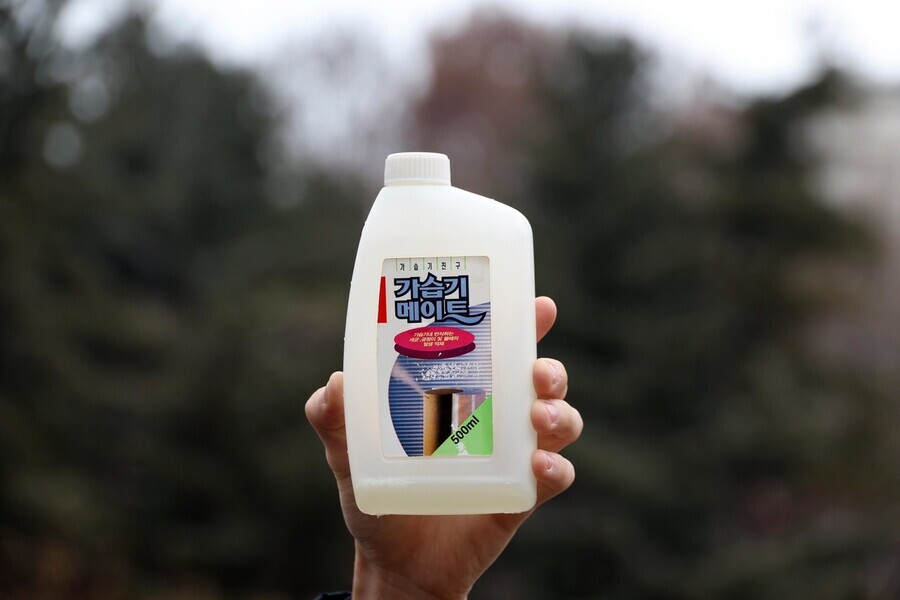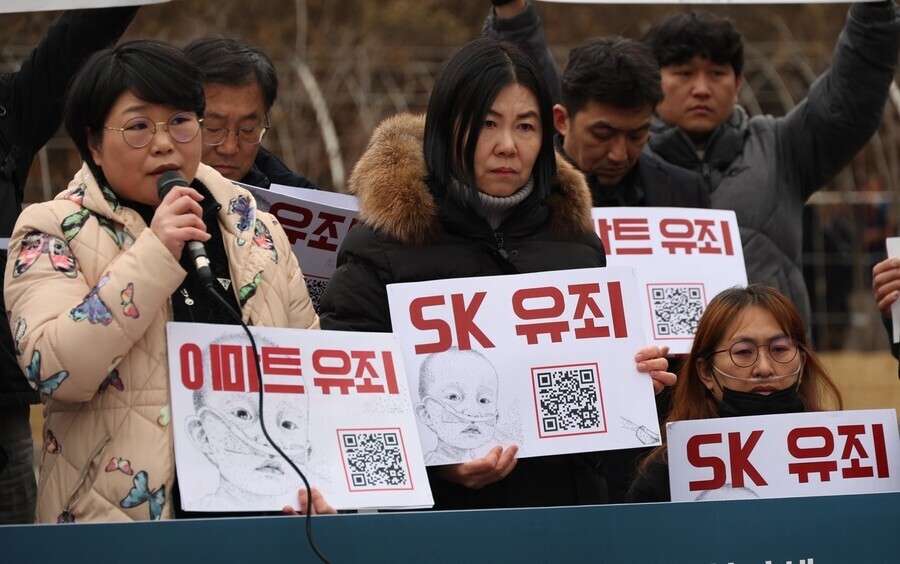hankyoreh
Links to other country sites 다른 나라 사이트 링크
13 years after toxicity revelations, Korean court convicts final makers of deadly humidifier disinfectants

Over a decade after revelations that common humidifier disinfectants contained toxins that had made thousands of people sick and killed hundreds more in South Korea, all manufacturers of the household products have finally been found guilty in courts of law.
On Thursday, the fifth criminal division of the Seoul High Court convicted former executives of humidifier disinfectant manufacturers for producing goods with the toxic substances chloromethylisothiazolinone (CMIT) and methylisothiazolinone (MIT), acknowledging the criminal liability of all companies implicated in the disaster.
This conviction comes 13 years after the tragedy first made headlines in August 2011.
While a lower court’s ruling found the manufacturers not guilty on the basis that “no tests proved that the substances in question caused or aggravated lung disease, or that it even reached the lungs,” an appellate court found the humidifier disinfectant itself toxic and stated that its adverse effects on the human body had been proven.
This indicates that after the lower court’s ruling, the court accepted the victims’ protests that their “bodies are proof” and criticisms made by the scientific and legal communities that the court relied on general rules of thumb rather than scientific standards to determine the credibility of scientific evidence.
A National Institute of Environmental Research study published late last year that confirmed the migration of CMIT and MIT from humidifier disinfectants through the respiratory tract to the lungs also acted as a decisive factor in the court’s judgment, as well as additional studies that have been conducted since the first trial proving the causal relationship between the substances in the humidifier disinfectants and pulmonary disease.
“When taking research of experts into account, it is no longer plausible to conclude that CMIT and MIT are unlikely to cause or aggravate lung disease or asthma,” the court ruled. “The specific causal relationship between the use of the humidifier disinfectants and lung disease is recognized as credible.”
The number of victims of these toxic humidifier disinfectants recognized by the government alone is 5,667, including 1,258 deaths.
However, it took more than five years for the companies responsible to finally be brought to justice. The first conviction came from a Seoul Central District Court criminal panel in January 2017, which found the executives of humidifier disinfectant manufacturers Oxy Reckitt Benckiser and Cefu guilty of occupational or gross negligence.
The companies in question used the toxic chemical polyhexamethylene guanidine (PHMG) in their humidifier disinfectants. At the time, the court sentenced Oxy’s former CEO to seven years in prison for having marketed and sold the product as safe, despite not carrying out adequate inhalation toxicity testing, leading to the deaths of 73 people. Prosecutors had sought 20 years in prison.
The families of the victims were outraged, calling it a “wishy-washy verdict that aggravated instead of resolving the injustice felt by the victims.” However, seven years in prison was the maximum sentence that could be imposed on the defendants on charges of occupational or gross negligence and false advertising.
On appeal, the manufacturer’s chief received a year off his sentence and was released in 2022.
SK Chemical and Aekyung Industrial, which were found guilty on Thursday, used different chemical substances in their humidifier disinfectants: CMIT and MIT.
Out of the 5,667 humidifier disinfectant victims officially recognized by the government as of the end of 2023, 41% (2,312 people) used products that contained the two substances.

The first humidifier disinfectants sold by Yugong, the company that eventually became SK Innovation, in 1994 contained the aforementioned substances, showing that the two substances were used in humidifier disinfectants long before PHMG was utilized.
However, the companies were not declared guilty until recently because of the claim that it was difficult, in comparison to products using PHMG, to prove the substances in question were the cause of pulmonary illnesses by those who used the humidifier disinfectants.
Prosecution of the two manufacturer’s executives did not begin in earnest until November 2018, when the Ministry of Environment released a report stating that these substances could influence lung disease in the same way as PHMG.
In addition to the problems of causality, the appellate court actively criticized the fact that Yugong first launched the product containing CMIT and MIT in 1994 while ignoring internal calls for toxicity tests, and continued sales the following year even after the Seoul National University College of Veterinary Medicine said there was a need for further testing, as there was room for debate about their safety.
“This judgment answers the question, ‘If we could turn back time, would we have behaved differently?’” the court stated in its ruling. The bench said it had found it “incredibly emotionally distressing” to read the statements of individuals harmed by the toxins.
Separately from this criminal case, the families of those killed or harmed by the noxious products filed a civil lawsuit in January 2012 seeking damages against the manufacturers and the state for failing to prevent the tragedy.
However, a settlement was reached between the families and the manufacturers midway through the case, turning the case into one between the families and the state.
The courts sided with the state in January 2015, calling it “difficult to see how the state was responsible for identifying the safety of the humidifier disinfectant and for stopping its sale.”
The first court ruling in a civil case recognizing a manufacturer’s liability for damages in the toxic humidifier disinfectant case was made in November 2016. At the time, a civil panel of the Seoul Central District Court ordered the manufacturer to pay up to 100 million won (US$76,000) in compensation to each of the 13 plaintiffs who had filed a lawsuit against the manufacturer and the state.
However, the state has once again dodged the bullet of blame. The fight of the victims to recognize the state’s responsibility for the harm caused by toxic products is still ongoing in the court of appeal.
By Kim Jeong-su, senior staff writer
Please direct questions or comments to [english@hani.co.kr]

Editorial・opinion
![[Editorial] Intensifying US-China rivalry means Seoul must address uncertainty with Beijing sooner than later [Editorial] Intensifying US-China rivalry means Seoul must address uncertainty with Beijing sooner than later](https://flexible.img.hani.co.kr/flexible/normal/500/300/imgdb/original/2024/0517/8117159322045222.jpg) [Editorial] Intensifying US-China rivalry means Seoul must address uncertainty with Beijing sooner than later
[Editorial] Intensifying US-China rivalry means Seoul must address uncertainty with Beijing sooner than later![[Column] When ‘fairness’ means hate and violence [Column] When ‘fairness’ means hate and violence](https://flexible.img.hani.co.kr/flexible/normal/500/300/imgdb/original/2024/0516/7417158465908824.jpg) [Column] When ‘fairness’ means hate and violence
[Column] When ‘fairness’ means hate and violence- [Editorial] Yoon must stop abusing authority to shield himself from investigation
- [Column] US troop withdrawal from Korea could be the Acheson Line all over
- [Column] How to win back readers who’ve turned to YouTube for news
- [Column] Welcome to the president’s pity party
- [Editorial] Korea must respond firmly to Japan’s attempt to usurp Line
- [Editorial] Transfers of prosecutors investigating Korea’s first lady send chilling message
- [Column] Will Seoul’s ties with Moscow really recover on their own?
- [Column] Samsung’s ‘lost decade’ and Lee Jae-yong’s mismatched chopsticks
Most viewed articles
- 1[Editorial] Transfers of prosecutors investigating Korea’s first lady send chilling message
- 2[Exclusive] Unearthed memo suggests Gwangju Uprising missing may have been cremated
- 3[Column] US troop withdrawal from Korea could be the Acheson Line all over
- 4Xi, Putin ‘oppose acts of military intimidation’ against N. Korea by US in joint statement
- 5[Column] When ‘fairness’ means hate and violence
- 6[Editorial] Intensifying US-China rivalry means Seoul must address uncertainty with Beijing sooner t
- 7‘Shot, stabbed, piled on a truck’: Mystery of missing dead at Gwangju Prison
- 8Spotlight turns to Hyundai Group Chairwoman’s visit to North Korea
- 9[Column] Samsung’s ‘lost decade’ and Lee Jae-yong’s mismatched chopsticks
- 10[Column] Will Seoul’s ties with Moscow really recover on their own?